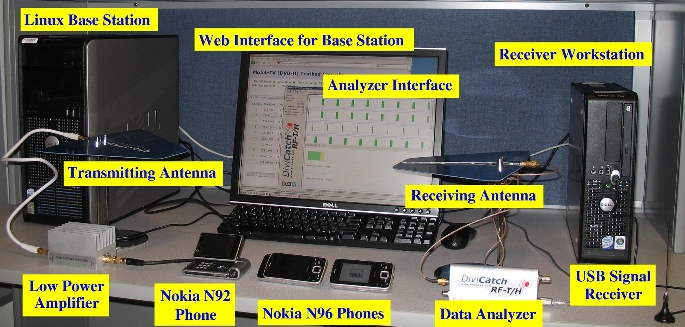Mobile TV allows users to watch their favorite TV shows and games on small hand-held devices while traveling. It, therefore, extends the Prime Time viewing of users and provides more business opportunities for content providers. The market for mobile TV is huge: it is expected to grow to up to 20 billion Euros with 500 million customers by 2011 (reference). In fact, mobile TV has already been deployed in parts of Europe and Asia and in pilot-testing in several locations in North and South Americas (official DVB-H site). This rapid adoption is fueled by the desire of users for multimedia content and by the technological advances in wireless mobile devices, such as personal digital assistants (PDAs), smart cellular phones, and mobile media players. Many of these devices have evolved to almost full-fledged mobile computers with high resolution displays, fast network links, large memory and storage space, and fast processors. Therefore, multimedia content can be rendered on most of these mobile devices, which further stimulates the user demands for more content and better quality.
A common issue in all mobile wireless devices is the limited energy supply since they are battery powered. Thus, minimizing the energy consumption in mobile TV networks becomes a critical problem for the success and wide adoption of such systems. Another important issue is reducing the channel switching delay. We address these two important problems. We develop algorithms
In this project, we consider the problem of controlling the switching delay in DVB-H networks that employ time slicing to save energy. Our goal is to provide a guarantee on the maximum switching delay from a TV channel to any other channel, without scarifying the energy saving for mobile devices. In our recent work [2], we analyzed the time slicing scheme currently used in many deployed mobile TV networks, and we showed that it is not efficient in terms of minimizing the energy consumption for mobile devices, especially when short channel switching delays are required. We have also proposed new optimal time slicing schemes that ensure that a given maximum switching delay is not exceeded. We proved the correctness of the proposed schemes and derived closed-form equations for the achieved energy saving.
We consider energy optimization in mobile TV networks in which a base station concurrently broadcasts
multiple digital TV channels to mobile devices over a common wireless medium.
We are also interested in video broadcasting to mobile devices in systems such as DVB-H (Digital Video Broadcast--Handheld). These systems provide TV services to mobile devices. We are working on algorithms to broadcast IP packets to mobile devices such that their wireless reception components can sleep for the longest possible period of time (and hence save energy) while maintaining good video quality.
People
- Cheng-Hsin Hsu (PhD student)
- Yi Liu (MSc student)
Publications
- M. Hefeeda, C. Hsu, and Y. Liu, Testbed and Experiments for Mobile TV (DVB-H) Networks, ACM Multimedia'08 Technical Demonstration, Vancouver, Canada, October 2008.
- M. Hefeeda and C. Hsu, On Burst Transmission Scheduling in Mobile TV Broadcast Networks, School of Computing Science, Simon Fraser University, August 2008.
- C. Hsu and M. Hefeeda, Bounding Switching Delay in Mobile TV Broadcast Networks, School of Computing Science, Simon Fraser University, July 2008.
Mobile TV (DVB-H) Testbed and Experiments
This testbed is used to evaluate several of our algorithms that aim to improve mobile TV quality and usability. We configure a commodity Linux workstation as our streaming server as well as IP encapsulator that converts a video over IP stream into a MPEG-2 transport stream. This Linux workstation also hosts a PCI-based DVB-H modulator card that is connected to an in-door antenna. We currently use Nokia N92 mobile phone as TV receivers, which enables us to gather several performance metrics such as video quality, CPU loads, and energy consumption (battery-life). In particular, this testbed consists of:
- An Intel Quad-Core Xeon E5420 (2.5 GHz) PC running Ubuntu Linux.
- A Dektec DTA-110T DVB-T/H Modulator and UHF Upconverter for PCI Bus.
- A Nokia N-92 mobile TV phone.
- Open source IP encapsulator software from http://amuse.ftw.at/downloads/encapsulator .
Discussion and Ideas
- Extend power awareness to WiMax and TDMA networks.
References and Links
- Wing-TV Project: Docs to test and to verify in detail the DVB-H specification.
- J. Wang, M. Venkatachalam, and Y. Fang, System Architecture and Cross-Layer Optimization of Video Broadcast over WiMAX, IEEE JSAC 25(4), pp. 712--721, MAY 2007. (Check this special issue of JSAC as well.)
- G. Gardikis, G. Xilouris, C. Skianis, Broadband multimedia on the move with DVB-H, Multimedia Tools and Applications, 36(1-2), January 2008. (DVB-H tutorial in inter-active mode.)

